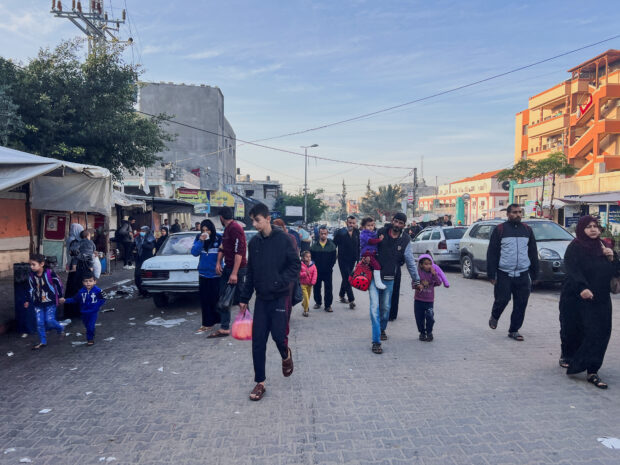Israel, Hamas start first truce in Gaza war

Palestinians walk on a street during a temporary truce between Hamas and Israel, in Khan Younis in the southern Gaza Strip, Novemeber 24, 2023. REUTERS/Saleh Salem
DOHA/GAZA — Israel and Hamas started a four-day ceasefire on Friday with the militants set to release 13 Israeli women and child hostages later in the day and aid to flow into the besieged Gaza enclave, the first pause in the near seven-week-old war.
The truce began at 7 a.m. (0500 GMT), involving a comprehensive ceasefire in north and south Gaza, and was to be followed by the release of some of the more than 200 hostages taken by Hamas during the Islamists’ Oct. 7 attack inside Israel, mediators in Qatar said. A number of Palestinian prisoners held in Israeli prisons were to be freed in exchange.
READ: Palestinians walk on a street during a temporary truce between Hamas and Israel, in Khan Younis
Fighting raged on in the hours leading up to the truce, with officials inside the Hamas-ruled enclave saying a hospital in Gaza City was among the targets bombed. Both sides also signalled the pause would be temporary before fighting resumes.
The Indonesian hospital was reeling under relentless bombing, operating without light and filled with bedridden old people and children too weak to be moved, Gaza health officials said. Al-Jazeera quoted Mounir El Barsh, the Gaza health ministry director, as saying a patient, a wounded woman, was killed and three others injured.
Additional aid would start flowing into Gaza and the first hostages, including elderly women, would be freed at 4 p.m. (1400 GMT), with the total number rising to 50 over the four days, Qatar’s foreign ministry spokesperson Majed Al-Ansari said in Doha.
Article continues after this advertisementREAD: Israel approves ceasefire with Hamas that includes release of some 50 hostages
Egypt said 130,000 litres of diesel and four trucks of gas will be delivered daily to Gaza when the truce starts, and that 200 trucks of aid would enter Gaza daily.
Article continues after this advertisementPalestinians were expected to be released from Israeli jails, the Qatari spokesperson told reporters. “We all hope that this truce will lead to a chance to start a wider work to achieve a permanent truce.”
Hamas confirmed on its Telegram channel that all hostilities from its forces would cease.
‘Temporary truce’
But Abu Ubaida, spokesperson for Hamas’ armed wing, later referred to “this temporary truce” in a video message that called for an “escalation of the confrontation with (Israel) on all resistance fronts”, including the Israeli-occupied West Bank where violence has surged since the Gaza war erupted almost seven weeks ago.
Israel’s military said its troops would stay behind a ceasefire line inside Gaza, without giving details of its position.
“These will be complicated days and nothing is certain,” Israeli military spokesperson Daniel Hagari said.
“Control over northern Gaza is the first step of a long war, and we are preparing for the next stages,” he added. Israel had received an initial list of hostages to be freed and was in touch with families, the prime minister’s office said.
Israel launched its devastating invasion of Gaza after gunmen from Hamas burst across the border fence on Oct. 7, killing 1,200 people and seizing about 240 hostages, according to Israeli tallies.
Since then, Israel has rained bombs on the tiny enclave, killing some 14,000 Gazans, around 40% of them children, according to Palestinian health authorities.
“People are exhausted and are losing hope in humanity,” U.N. Palestinian refugee agency UNRWA’s Commissioner-General Philippe Lazzarini said on Thursday after a visit to Gaza, referring to “unspeakable suffering” in the enclave.
“They need respite, they deserve to sleep without being anxious about whether they will make it through the night. This is the bare minimum anyone should be able to have.”
Ahead of the ceasefire, fighting became even more intense on Thursday, with Israeli jets hitting more than 300 targets and troops engaged in heavy fighting around Jabalia refugee camp north of Gaza City.
An army spokesperson said operations would continue until troops received the order to stop.
International alarm has focused on the fate of hospitals, especially in Gaza’s northern half, where all medical facilities have ceased functioning with patients, staff and displaced people trapped inside.
Israel says Hamas fighters use residential and other civilian buildings, including hospitals, as cover – a charge that Hamas denies.